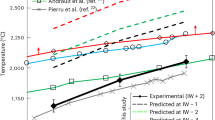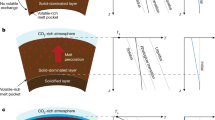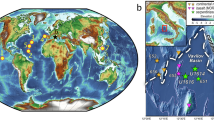Abstract
The distribution of geochemical species in the Earth’s interior is largely controlled by fractional melting and crystallization processes that are intimately linked to the thermal state and evolution of the mantle. The existence of patches of dense partial melt at the base of the Earth’s mantle1, together with estimates of melting temperatures for deep mantle phases2 and the amount of cooling of the underlying core required to maintain a geodynamo throughout much of the Earth’s history3, suggest that more extensive deep melting occurred in the past. Here we show that a stable layer of dense melt formed at the base of the mantle early in the Earth’s history would have undergone slow fractional crystallization, and would be an ideal candidate for an unsampled geochemical reservoir hosting a variety of incompatible species (most notably the missing budget of heat-producing elements) for an initial basal magma ocean thickness of about 1,000 km. Differences in 142Nd/144Nd ratios between chondrites and terrestrial rocks4 can be explained by fractional crystallization with a decay timescale of the order of 1 Gyr. These combined constraints yield thermal evolution models in which radiogenic heat production and latent heat exchange prevent early cooling of the core and possibly delay the onset of the geodynamo to 3.4–4 Gyr ago5.
This is a preview of subscription content, access via your institution
Access options
Subscribe to this journal
Receive 51 print issues and online access
$199.00 per year
only $3.90 per issue
Buy this article
- Purchase on SpringerLink
- Instant access to full article PDF
Prices may be subject to local taxes which are calculated during checkout




Similar content being viewed by others
References
Williams, Q. & Garnero, E. J. Seismic evidence for partial melt at the base of the Earth’s mantle. Science 273, 1528–1530 (1996)
Zerr, A., Diegeler, A. & Boehler, R. Solidus of Earth’s deep mantle. Science 281, 243–246 (1998)
Labrosse, S. Thermal and magnetic evolution of the Earth’s core. Phys. Earth Planet. Inter 140, 127–143 (2003)
Boyet, M. & Carlson, R. W. 142Nd Evidence for early (> 4.53 Ga) global differentiation of the silicate Earth. Science 309, 576–581 (2005)
Ozima, M. et al. Terrestrial nitrogen and noble gases in lunar soils. Nature 436, 655–659 (2005)
Stixrude, L. & Karki, B. Structure and freezing of MgSiO3 liquid in Earth’s lower mantle. Science 310, 297–299 (2005)
Mosenfelder, J. P., Asimow, P. D. & Ahrens, T. J. Thermodynamic properties of Mg2SiO4 liquid at ultra-high pressures for shock measurements to 200 GPa on forsterite and wadsleyite. J. Geophys. Res. 112 B06208 doi: 10.1029/2006JB004364 (2007)
Knittle, E. & Jeanloz, R. Earth’s core-mantle boundary: Results of experiments at high pressures and temperatures. Science 251, 1438–1443 (1991)
Braginsky, S. I. Dynamics of the stably stratified ocean at the top of the core. Phys. Earth Planet. Inter 111, 21–34 (1999)
Buffett, B. A. Earth’s core and the geodynamo. Science 288, 2007–2012 (2000)
Hofmann, A. W. Mantle geochemistry: The message from oceanic volcanism. Nature 385, 219–229 (1997)
Davaille, A. Simultaneous generation of hotspots and superswells by convection in a heterogeneous planetary mantle. Nature 402, 756–760 (1999)
Coltice, N. & Ricard, Y. Geochemical observations and one layer mantle convection. Earth Planet. Sci. Lett. 174, 125–137 (1999)
Allègre, C. J., Hofmann, A. & O’Nions, K. The argon constraints on mantle structure. Geophys. Res. Lett. 23, 3555–3557 (1996)
Sun, S. S. & McDonough, W. F. in Magmatism in the Ocean Basins (eds Saunders, A. & Norry, M.) 313–345 (Spec. Publ. Vol. 42, Geol. Soc. Lond., 1989)
Rudnick, R. L., Barth, M., Horn, I. & McDonough, W. F. Rutile-bearing refractory eclogites: Missing link between continents and depleted mantle. Science 287, 278–281 (2000)
Boyet, M. & Carlson, R. W. A new geochemical model for the Earth’s mantle inferred from 146Sm-142Nd systematics. Earth Planet. Sci. Lett. 250, 254–268 (2006)
Corgne, A., Liebske, C., Wood, B. J., Rubie, D. C. & Frost, D. J. Silicate perovskite-melt partitioning of trace elements and geochemical signature of a deep perovskitic reservoir. Geochim. Cosmochim. Acta 69, 485–496 (2005)
Mcdonough, W. F. & Sun, S. S. The composition of the Earth. Chem. Geol. 120, 223–253 (1995)
Rudnick, R. L. & Fountain, D. M. Nature and composition of the continental crust: A lower crustal perspective. Rev. Geophys. 33, 267–309 (1995)
Salters, V. J. M. & Stracke, A. Composition of the depleted mantle. Geochem. Geophys. Geosyst. 5 Q05004 doi: 10.1029/2003GC000597 (2004)
Hofmann, A. W. Chemical differentiation of the Earth: The relationship between mantle, continental crust and oceanic crust. Earth Planet. Sci. Lett. 90, 297–314 (1988)
Wen, L. X., Silver, P., James, D. & Kuehnel, R. Seismic evidence for a thermo-chemical boundary at the base of the Earth’s mantle. Earth Planet. Sci. Lett. 189, 141–153 (2001)
Thorne, M. S. & Garnero, E. J. Inferences on ultralow-velocity zone structure from a global analysis of SPdKS waves. J. Geophys. Res. 109 B08301 doi: 10.1029/2004JB003010 (2004)
Allègre, C. J., Staudacher, T. & Sarda, P. Rare gas systematics: Formation of the atmosphere, evolution and structure of the Earth’s mantle. Earth Planet. Sci. Lett. 81, 127–150 (1987)
Hernlund, J. W., Thomas, C. & Tackley, P. J. A doubling of the post-perovskite phase boundary and structure of the Earth’s lowermost mantle. Nature 434, 882–886 (2005)
Lay, T., Hernlund, J., Garnero, E. J. & Thorne, M. S. A post-perovskite lens and D” heat flux beneath the central Pacific. Science 314, 1272–1276 (2006)
Tarduno, J. A., Cottrell, R. D., Watkeys, M. K. & Bauch, D. Geomagnetic field strength 3.2 billion years ago recorded by single silicate crystals. Nature 446, 657–660 (2007)
Acknowledgements
We thank D. Stevenson for comments that helped us to considerably sharpen this paper. M. Moreira, C. Jaupart and M. Jellinek also provided valuable feedback. This research was supported by the SEDIT programme of INSU, the French Ministry of Research and a CIAR postdoctoral fellowship.
Author Contributions All authors contributed equally to the manuscript.
Author information
Authors and Affiliations
Corresponding author
Supplementary information
Supplementary Notes
The file contains Supplementary Notes with additional explanations, and in particular the equations for the Sm-Nd evolution, a figure representing the trade-offs between parameters to satisfy the constraints from Nd and a table of parameters used for the model evolution. (PDF 338 kb)
Rights and permissions
About this article
Cite this article
Labrosse, S., Hernlund, J. & Coltice, N. A crystallizing dense magma ocean at the base of the Earth’s mantle. Nature 450, 866–869 (2007). https://doi.org/10.1038/nature06355
Received:
Accepted:
Issue Date:
DOI: https://doi.org/10.1038/nature06355



